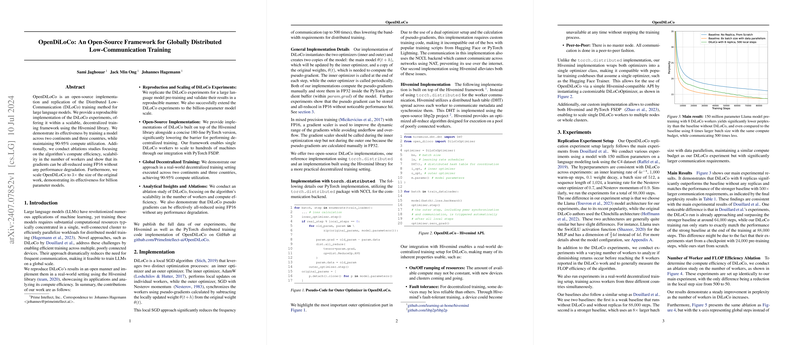OpenDiLoCo: An Open-Source Framework for Globally Distributed Low-Communication Training
The paper "OpenDiLoCo: An Open-Source Framework for Globally Distributed Low-Communication Training" introduces an open-source implementation of the Distributed Low-Communication (DiLoCo) training method for LLMs. This implementation, termed OpenDiLoCo, leverages the Hivemind library to create a decentralized training framework that can function effectively across multiple geographically dispersed nodes. The authors, Sami Jaghouar, Jack Min Ong, and Johannes Hagemann, provide a comprehensive reproduction of the original DiLoCo experiments and demonstrate its scalability to billion-parameter models.
Main Contributions
The paper presents several significant contributions:
- Replication and Scaling of DiLoCo Experiments: The authors reproduce DiLoCo experiments and extend the method to a more extensive scale involving billion-parameter models.
- Open-Source Implementation: The implementation is provided in both a concise 180-line PyTorch version and a more scalable version that integrates with Hivemind, catering to practical decentralized training scenarios.
- Global Decentralized Training: The authors validate the viability of their framework by training a model across nodes located on different continents and countries, achieving high compute utilization.
- Analytical Insights: Detailed ablation studies focus on the algorithm's scalability and compute efficiency, including an analysis of FP16-based gradient reductions.
Implementation Details
The OpenDiLoCo framework employs a local SGD algorithm, consisting of dual optimizers: an inner optimizer (AdamW) for local updates and an outer optimizer (SGD with Nesterov momentum) for global synchronization. This innovative methodology significantly reduces communication frequency (up to 500 times), thereby diminishing bandwidth requirements.
The authors provide two distinct implementations:
- torch.distributed-based implementation: This version uses NCCL for communication and requires custom training code, making it less compatible with popular training scripts.
- Hivemind-based implementation: Built upon the Hivemind framework, this version addresses compatibility issues and enables peer-to-peer, fault-tolerant communication using a distributed hash table (DHT).
Experimental Setup and Results
The experiments were primarily conducted with a model architecture based on Llama, instead of the Chinchilla architecture used in previous studies. The authors implemented various experiments on a 150 million-parameter model and eventually scaled up to a 1.1 billion-parameter model.
Key Findings:
- Performance: In the context of 150 million-parameter models, eight DiLoCo workers demonstrated perplexity comparable to large batch size baselines, while communicating substantially less. DiLoCo’s FLOP efficiency improved with more training steps.
- FP16 All-Reduce: Transitioning to FP16 for pseudo-gradient all-reductions showed no noticeable performance degradation, effectively reducing communication time.
- Scalability: The OpenDiLoCo framework extended successfully to 1.1 billion-parameter models, indicating its potential for larger scales while maintaining communication efficiency.
- Global Training Setting: The authors demonstrated practical decentralized training across globally distributed nodes, achieving 90-95% compute utilization.
Implications and Future Directions
The implications of OpenDiLoCo are substantial for both theoretical research and practical applications in distributed AI training:
- Reduction in Communication Overheads: The method provides a valuable approach to mitigate communication bottlenecks, particularly advantageous for globally distributed training setups.
- Scalability: Demonstrating scalability to billion-parameter models opens avenues for training even larger models without the necessity of highly connected clusters.
- Compatibility with Existing Tools: By ensuring compatibility with prevalent frameworks like PyTorch and Hugging Face, OpenDiLoCo can bolster adoption and integration into diverse research environments.
Future developments may focus on enhancing compute efficiency further and exploring asynchronous communication strategies to reduce idle times during training. Investigating more sophisticated model merging techniques could yield improved stability and faster convergence. Moreover, extending the framework’s applicability to even larger models will be crucial for maintaining its relevance in the evolving landscape of AI research.
Conclusion
The paper effectively reproduces and scales the DiLoCo method, providing a robust, open-source framework for decentralized training of LLMs. The advantageous reduction in communication overhead, combined with high compute utilization achieved across a globally distributed setup, underscores the practical and theoretical value of OpenDiLoCo in advancing decentralized AI training methodologies. The authors’ comprehensive implementation and rigorous analysis pave the way for future innovations in this domain.
